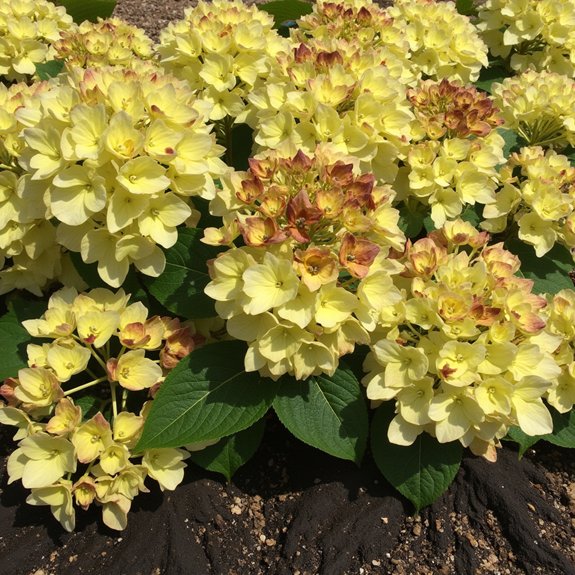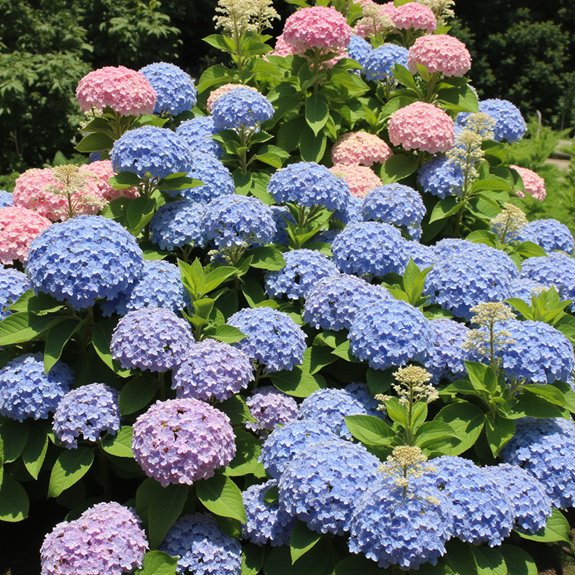You’ve noticed those gorgeous hydrangea blooms turning an unsightly brown, haven’t you? This frustrating issue isn’t just bad luck—it’s your plant sending a distress signal. The culprit typically lies in two critical care factors: water management and light exposure. Most gardeners unknowingly trigger this browning through inconsistent watering schedules or improper sun placement. But here’s what most people don’t realize about timing.
Contents
Common Culprits Behind Premature Flower Browning

When your hydrangea blooms start turning brown weeks before the first frost hits, you’re dealing with premature browning rather than the natural end-of-season color change. Heat stress and insufficient watering are the primary environmental stressors behind these unwanted flower color changes.
Poor growing conditions trigger early browning, robbing you of weeks of beautiful blooms. Extreme temperatures combined with inadequate moisture create the perfect storm for flower deterioration.
The good news? You can prevent this premature aging with proper care, keeping your hydrangeas vibrant until nature’s intended timeline takes over.
Mastering the Perfect Hydrangea Watering Schedule
Consistency becomes your greatest ally in preventing hydrangea flower browning, and establishing a reliable watering schedule forms the foundation of healthy blooms. Your hydrangeas need approximately one inch of water weekly, applied directly at the plant’s base for ideal absorption.
Effective hydrangea care requires monitoring soil moisture levels regularly. The soil should feel moist, not muddy, indicating proper hydration. Mastering proper watering techniques means delivering water slowly and deeply, allowing thorough root penetration.
Use a rain gauge to track natural rainfall, then adjust your supplemental watering accordingly. This precision prevents both overwatering and underwatering issues that commonly cause premature browning.
Recognizing the Warning Signs of Overwatering

How can you tell if your well-intentioned watering efforts have crossed the line into plant drowning territory? Watch for yellowing leaves, which signal classic overwatering symptoms affecting your plant’s health.
When leaves start falling off despite regular care, you’ve likely overdone it. Check your soil by pressing a finger two inches deep. If it feels muddy rather than moist, take a watering break immediately.
Use a simple rain gauge to track natural rainfall, then adjust your schedule accordingly. Remember, hydrangeas need moisture, not a swimming pool around their roots.
Identifying and Addressing Water-Starved Plants
While overwatering drowns your hydrangeas, the opposite problem leaves them gasping for moisture with equally dramatic symptoms. Crispy, brittle leaves signal dehydration, while droopy flowers appear lifeless during midday heat. You’ll notice these warning signs most prominently during hot afternoons.
Effective hydration techniques require slow, deep watering at the plant’s base for ideal water absorption. Apply water gradually, allowing soil to soak thoroughly rather than rushing the process. Morning and evening sessions work best, giving roots time to drink before intense heat arrives.
Check soil moisture by inserting your finger two inches deep—it should feel consistently moist, never bone dry.
Finding the Right Light Balance for Healthy Blooms

Just as hydrangeas demand precise watering schedules, they’re equally particular about their sunlight requirements for preventing flower browning. Large-leaved varieties need partial shade, thriving with four to six hours of daily sun exposure. Light intensity matters greatly here.
Panicle hydrangeas handle full sun conditions much better than their shade-loving cousins. If you’ve planted shade requirements hydrangeas in overly sunny spots, consider transplanting them to areas with morning sun and afternoon protection.
Container gardening offers flexibility for adjusting sun exposure throughout growing seasons, letting you move plants as needed.
